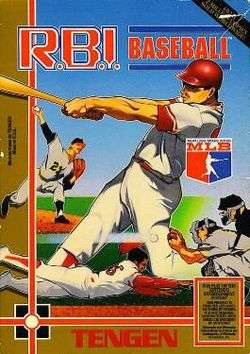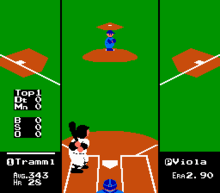R.B.I. Baseball
| R.B.I. Baseball | |
|---|---|
 Cover art of R.B.I. Baseball, the first title of the series | |
| Developer(s) |
Atari Games (arcade) Tengen (1988-1995) Novotrade (Home computers, 2) Gray Matter (Super RBI) Behaviour Interactive (14) HB Studios (15, 16) MLB Advanced Media (17-present) |
| Publisher(s) |
Atari Games (arcade) Tengen (1988-1994) Domark (Home computers, 2) Time Warner Interactive (1995) MLB Advanced Media (14-present) |
| Platforms | Nintendo VS. System, Nintendo Entertainment System, Commodore 64, Commodore Amiga, ZX Spectrum, Atari ST, Sega Genesis/Mega Drive, Sega Game Gear, Super Nintendo Entertainment System, Sega 32X, PlayStation 3, PlayStation 4, Xbox 360, Xbox One, Android, iOS, Steam, Nintendo Switch |
| Platform of origin | Nintendo VS. System |
| First release |
Atari R.B.I. Baseball September 1987 |
| Latest release |
R.B.I. Baseball 18 March 20, 2018 |
R.B.I. Baseball is a baseball video game series. R.B.I. is an initialism for "run batted in".
History
Namco developed and released Pro Yakyuu Family Stadium for the Family Computer on December 10, 1986. Atari Games released a Nintendo VS. System arcade machine of Family Stadium named Atari R.B.I. Baseball in 1987[1] and its programmer, Peter Lipson, developed an NES version published by Atari Games' subsidiary Tengen.
Gameplay and features

RBI Baseball was the first console game of its kind to be licensed by the Major League Baseball Players Association (MLBPA) and used actual MLB player names, unlike other baseball video games of the late 1980s. As it was not licensed by Major League Baseball (MLB) itself, it did not use team nicknames or logos. Instead, the game contained 8 teams listed by only their location: Boston, California, Detroit, Houston, Minnesota, New York, St. Louis, and San Francisco; their real-life, MLB counterparts were the first place teams in each division in 1986 (Boston, California, Houston, New York) and 1987 (Detroit, Minnesota, St. Louis, San Francisco) MLB seasons. The game also boasted two All-Star teams, American League and National League; the two featured established veterans such as George Brett, Dale Murphy and Andre Dawson—none of whom appeared on the other eight teams—and up-and-coming players like Mark McGwire, Andrés Galarraga, Kevin Seitzer and José Canseco.
Each player has different capabilities in the game; hitters vary in ability to make solid contact, to hit the ball with power, and their base running speed. Vince Coleman is the fastest player in the game; it is very difficult to catch him stealing second base. Pitchers vary in pitching speed, and the amount by which the player can steer the ball left and right during its flight. Pitchers also have varying stamina; as a pitcher gets tired, the ball slows down and is harder to steer. Nolan Ryan and Roger Clemens are two pitchers in the game with the fastest pitches. Fernando Valenzuela, without a hard fastball, has tremendous movement in both directions with his pitches. Mike Scott has a sharp and deceptive breaking ball. The best pitcher is debatable, depending on how they are used by the players. There is no evidence that fielding abilities correspond to individual players.
The abilities of each player do not necessarily correspond with the statistics shown on the screen when the player comes to bat or takes the mound. These statistics are generally accurate, with many exceptions (see below). They do not change during the course of the game or sequence of games.
A rudimentary box score is displayed during and after the game showing composite statistics for each team. A hit batter is credited with a walk, and anyone reaching on an error gets credited for a hit even as the other team is charged with an error. Conversely, a batter thrown out while trying for extra bases is not credited with a hit.
The infield fly rule is not implemented.
The rosters for the eight teams are fairly accurate if simplified representations of the playoff rosters from their respective years. Each team has 8 starting batters, four bench players, two starting pitchers and two relievers. The player can start any pitcher they like, though the relievers have very low stamina. But if they play consecutive games without resetting the system, any starting pitcher used in the previous game will be unavailable. The player has to wait until the game starts before substituting players with pinch hitters, who can play any position. Pinch runners are not implemented.
Unlike Major League Baseball, R.B.I. Baseball implements the mercy rule -- if one team is ahead by ten or more runs after any number of completed innings, the game ends immediately.
Additionally, while the statistics shown on the screen for each player in the original game were reasonably accurate, their playing attributes were not always accurate. For example, George Brett was depicted in-game as a right-handed batter, while the real-life Brett batted left-handed. Also, all real-life switch hitters, such as Tim Raines, were depicted exclusively as left-handed batters.[2]
In Vs. RBI Baseball, the teams are made up of legends from 10 different franchises. These players were statistically represented with their best seasons. A notable exception was that of McGwire, who was included on the Oakland team, and was statistically represented by his potential numbers. In a remarkable display of foresight, he was projected to hit 62 home runs in his best season. In 1998, he set the then-major league record for home runs in a season with 70.
Games
| Title | Details |
|---|---|
Atari R.B.I. Baseball Original release dates:
|
Release years by system: 1987 – Nintendo VS. System 1988 – Nintendo Entertainment System |
Notes:
| |
R.B.I. Baseball 2 Original release dates:
|
Release years by system: 1990 – Nintendo Entertainment System 1991 – Commodore 64, Amiga |
R.B.I. Baseball 3 Original release dates:
|
Release years by system: 1991 – Nintendo Entertainment System, Sega Genesis |
R.B.I. Baseball 4 Original release dates:
|
Release years by system: 1992 – Sega Genesis |
| Notes:
Cory Walker of Lebanon, TN is widely considered the greatest R.B.I. 4 baseball player in history. In 2004, he was the first person inducted into the RBI 4 baseball hall of fame. In 2004, he issued a open challenge to anyone in the world. To this day, he has not been beat. Walker coined several player nicknames including Turlet Bowl (Danny Tartabull), Rickey Hen (Rickey Henderson), Hojo (Howard Johnson), Cal Rip (Cal Ripken Jr.), Paul Mall (Paul Molitor), K Mitch (Kevin Mitchell). When asked who the best player in the game is, Walker said "Kevin Mitchell...if you give him a pitch to hit he will make you pay." Walker is also known for his signature diving catches. | |
R.B.I. Baseball '93 Original release dates:
|
Release years by system: 1993 – Sega Genesis |
R.B.I. Baseball '94 Original release dates: |
Release years by system: 1994 – Sega Genesis, Sega Game Gear |
Original release date(s):
|
Release years by system: 1995 – Super Nintendo Entertainment System |
Original release date(s):[3][4]
|
Release years by system: 1995 – Sega 32X |
R.B.I. Baseball 14 Original release dates:[5]
|
Release years by system: 2014 – PlayStation 3, PlayStation 4, Xbox 360, Xbox One, Android, iOS, Steam |
Notes:
| |
R.B.I. Baseball 15 Original release dates:[5]
|
Release years by system: 2015 – PlayStation 4, Xbox One, Android, iOS, Steam |
Notes:
| |
R.B.I. Baseball 16 Original release dates:[5]
|
Release years by system: 2016 – PlayStation 4, Xbox One, Android, iOS, Steam |
Notes:
| |
R.B.I. Baseball 17 Original release dates:[5]
|
Release years by system: 2017 – PlayStation 4, Xbox One, Android, iOS, Nintendo Switch |
Notes:
| |
R.B.I. Baseball 18 Original release dates:[5]
|
Release years by system: 2018 – PlayStation 4, Xbox One, Android, iOS, Nintendo Switch |
Notes:
|
Reception
IGN called R.B.I. Baseball 14 and 15 "bad".[6][7] Forbes gave bad reviews to 16,[8] 17,[9] and 18. 18 was criticized for it's animation and collision detection.[10] Polygon called R.B.I. Baseball 18 "primitive".[11]
References
- ↑ "Atari R.B.I. Baseball". Killer List of Videogames. Retrieved 27 April 2016.
- ↑ Passan, Jeff (July 27, 2017). "The legacy of Tim Raines, old-school Nintendo and 'RBI Baseball'". Yahoo! Sports. Retrieved July 29, 2017.
- ↑ "RBI '95". Next Generation. No. 7. Imagine Media. July 1995. p. 69.
- ↑ "RBI '95 Goes Deep on the 32X". GamePro. No. 84. IDG. September 1995. p. 74.
- 1 2 3 4 5 Sarkar, Samit (2018-01-22). "Exclusive: Why MLB decided to develop R.B.I. Baseball 18 itself". Polygon. Retrieved 2018-01-24.
- ↑ "RBI Baseball 14 Review". IGN. 2014-04-15.
- ↑ "RBI Baseball 15 Review". IGN. 2015-04-08.
- ↑ "'R.B.I Baseball 16' Review: You Get What You Pay For". Forbes. 2016-04-11.
- ↑ "'R.B.I Baseball 17' Review: In Foul Territory". Forbes. 2017-04-04.
- ↑ "'R.B.I' Baseball 18' Review: The Good, The Bad And The Bottom Line". Forbes. 2018-04-01.
- ↑ "R.B.I. Baseball 18 strives for arcade and sim, and falls short of both". Polygon. 2018-04-04.